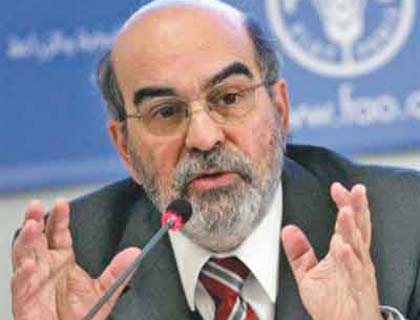Economic advance in Asia and the Pacific has been impressive in the last decades. A recent World Bank report talks about the dramatic progress in poverty reduction across the region. In 1981, 77 percent of Asians lived in poverty – but by 2008 the proportion was just 14 percent. Nonetheless the Asia-Pacific region remains home to two out of every three of the world's hungry. Sixty-two percent of the undernourished population of the world lives in this region. That means around half a billion people hungry; that is half a billion too many.
The region's challenge over the next decades to 2050 will therefore be threefold: to eradicate hunger and assure everyone's right to food; to increase agricultural production in the face of climate change and rapid urbanization; and to do in an environmentally, socially and economically sustainable manner.
Those are of course global challenges, facing populations not just in Asia but elsewhere too. But they are of particular relevance to the world's most populous region, which is home to the vast majority of the world's small farms and where almost all of the potential arable land is already in use.
It follows that much of the food needed to feed approximately two billion extra mouths between now and mid-century will need to come from intensifying smallholder agriculture on existing land rather than by opening up new areas for cultivation. Doing this without further jeopardizing delicate ecosystems and limited natural resources calls for new and sustainable approaches.
In rice production, for example, new Sustainable Rice Intensification techniques that include non-flooded, aerobic rice fields are starting to replace traditional paddies. Smallholders can achieve yield increases of a ton per hectare or more, while sharply reducing water and fertilizer use and greenhouse emissions. But while producing more food is vital, it is not enough.
The world already has enough food, and yet 925 million people are undernourished. The main cause of hunger is lack of adequate access. The main issue is assuring that, starting at the local level, people have the money to buy food or can grow enough for themselves and their families. Hunger may be a global challenge. But people eat in their homes, in their cities and villages.
That means breathing new life into rural communities through: support to small-scale farmers so they can produce more, sustainably, and have markets to sell to; cash transfers and cash for work programmes; rural employment creation; and targeted safety nets that put money in people's pockets, help to make sure their kids are well fed and go to school. Social and productive policies can and should be linked, to complete a virtuous cycle in which local consumption and production feed off each other.
Another aspect to consider in global and regional food balances is food consumption. Almost one person in two on this planet is either not eating enough, eating badly, or eating too much. On top of the world's 925 million hungry, more than a billion people suffer from micronutrient deficiencies while another billion are overweight or obese. Then again roughly one third of the food produced in the world for human consumption every year — approximately 1.3 billion tonnes — is lost or wasted.Cutting that waste would help keep food prices down, reduce pressure on natural resources and contain greenhouse gas emissions – and make people healthier too.
Of course ending hunger in Asia or indeed at global level requires a concerted international effort, which lends special significance to FAO's 31st Regional Conference for Asia and the Pacific taking place in Hanoi this week, with delegates from 40 countries.
Regional cooperation is key in addressing hunger, especially through South-South cooperation, which enables developing countries to benefit from the expertise of other developing or emerging economies.
FAO has 47 South-South cooperation agreements so far in the Asia Pacific region, with more than 1500 experts and technicians from 13 countries sharing what they know in 35 host countries. Bangladesh, China, India, Myanmar, Pakistan, Philippines and Viet Nam have been among the providers of South-South support.
Working together as part of the global community the Asia-Pacific region can ensure that its impressive economic advance is matched by rapid progress towards a hunger-free region.

